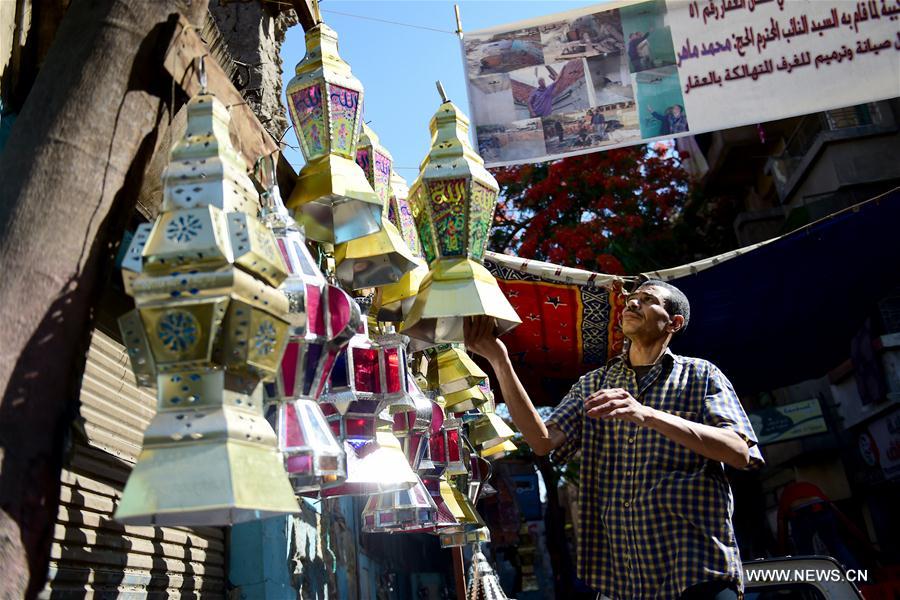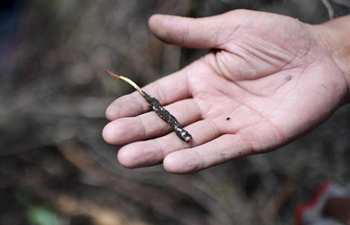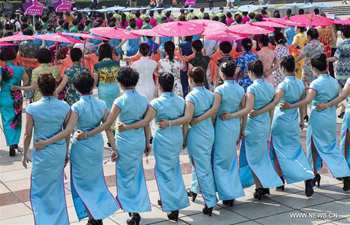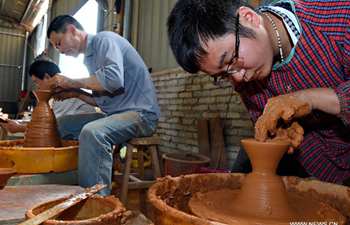
Hussein Sayyid displays traditional handmade lanterns outside his workshop in Cairo, Egypt, on May 20, 2017. Located inside an old building in a street full of workshops in Al-Qalaa, which means "the Citadel" in Arabic, referring to Cairo's Saladin Citadel, Sayyid's workshop produces colorful handmade glass and metal lanterns of different sizes, known in Arabic as "fanoos," displayed on stands outside the workshop. Traditional handmade lanterns usually serve as decorations in Egypt during the annual month of Ramadan. (Xinhua/Zhao Dingzhe)
by Mahmoud Fouly
CAIRO, May 24 (Xinhua) -- "Traditional handmade lanterns will never loose their appeal in Egypt during the annual month of Ramadan," said 42-year-old Egyptian lantern maker Hussein Sayyid Wednesday as he worked in his workshop in Cairo's Al-Qalaa neighborhood.
Sayyid has worked in this profession since he was four and his family inherited it from their fathers and grandfathers.
He learned the craft from his 58-year-old brother Ali who was taught it by their father.
"Perhaps lantern-makers will decrease in numbers because it's a family inherited craft and strangers don't usually learn it," the lantern-maker told Xinhua, noting that his children work with him at the workshop to learn the craft.
Located inside an old building in a street full of workshops in Al-Qalaa, which means "the Citadel" in Arabic, referring to Cairo's Saladin Citadel, Sayyid's workshop produces colorful handmade glass and metal lanterns of different sizes, known in Arabic as "fanoos," displayed on stands outside the workshop.
The messy room with its eroded, unpainted walls contains a main counter with a fire flame in the middle which Sayyid uses to fashion and weld the fanoos.
The main materials used in making the fanoos are glass plates, tinplates, tin in addition to the welding tools.
"Some regular customers come here every year to buy a fanoos, which is why they are on display for sale outside the workshop. However, some store owners buy large quantities and sell them," he said, adding that " the fanoos is still as popular as ever and it will remain popular despite the competition from imported toy-like lanterns."
Egypt has suffered an economic recession in the past few years which have been rife with political turmoil and related security issues, leading the country to adopt strict reform plans, austerity measures, local currency floatation and energy subsidy cuts.
The reform measures, supported by a 12 billion U.S. dollar loan from the International Monetary fund, amid dollar shortage whose exchange rate rose from 8 to over 18 Egyptian pounds, led to an unprecedented inflation and caused price hikes of almost every commodity in Egypt.
"Price increases greatly affected the fanoos market, more than doubling its price. A parent of three children who used to buy them three small fawanees (plural for fanoos in Arabic) for 60 pounds now has to pay 150 pounds. This medium-sized one used to be sold for 30 pounds and now it costs 70 pounds, definitely affecting sales," he told Xinhua.
He explained that soaring fawanees prices are due to rising prices of tinplates, glass plates and tin material, arguing that tin in his craft is as valuable as gold and its price is related to the dollar hike.
In the past, the fanoos was smaller with a door which opens in order to place a lit candle inside it, used by children to play with.
Now they are produced in larger sizes to be used decoratively in hotel entrances, lobbies, corridors, restaurants, offices and other places.
"Everyone thinks fanoos production is a seasonal handicraft, which is untrue as we work year-round. Some traders buy and store our products in order to sell them before and during Ramadan. Some merchants ask for larger fawanees to sell to hotels, companies, offices, stores and restaurants," said the fanoos maker.
Among the displayed fawanees, the most popular and sellable types are those called "the Star," "the Schweppes," "the Watermelon Slice," and "the Lamar."
Sayyid has three children whose ages range from two to nine, and he plans to pass the craft to them as his forefathers did with him.
"They love to come and watch me fashion a fanoos. It's a pleasurable experience for them. They help me in work and also sell to customers and to their peers," noted Sayyid, pointing to his eldest son Youssef, nine, and his daughter Fatma, seven, whom he nicknames Batta (duck in Arabic) as typically done in Egypt.
In another corner of the one-room workshop, Sayyid's two children are busy with tools twisting metal pieces and making fanoos domes before they hand them over to their father for welding.
"I am in fourth grade now and I have been working with my father for the last four years. I use a twisting tool to fashion the tinplate and my sister makes the fanoos dome. We stay clear away from fire and welding," said the little fanoos maker.
As for his sister Fatma, or Batta, the seven-year-old girl said that she loves fanoos making and that she has been working with her father since she was four.
"My father gifts me with a nice fanoos every Ramadan and he pays me five pounds for every working day," she said with a shy, innocent smile.















